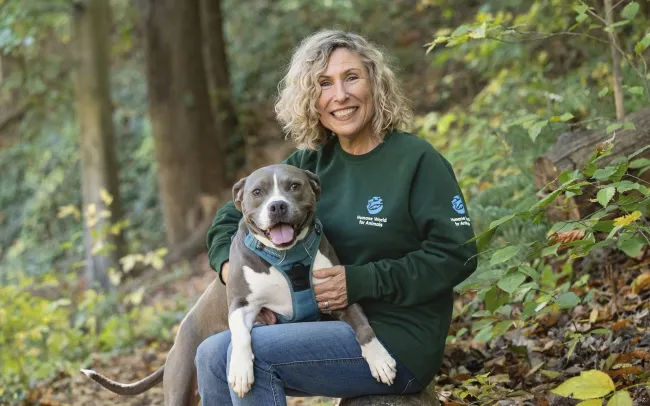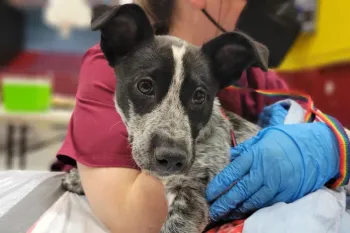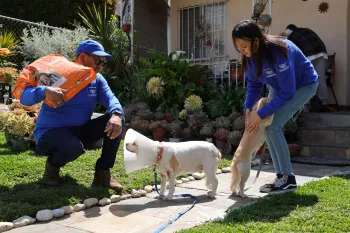A man recently told the Chicago Sun-Times that his dog was part of the family. It’s something we hear all the time from millions of animal lovers. But this man was standing in a line for two hours to relinquish her to a shelter because he couldn’t afford to give her the veterinary treatment she needs. “If I could afford her, I’d be at the vet right now…But you’ve got to choose between living, rent, gas for the car—or the dog. It’s hard.” His only hope was that another family might be able to provide the medical care she needed—a heartbreaking decision based solely on a lack of access to affordable veterinary care.
He is not alone. With inflation affecting almost every area of life, too, people are being pressed from all sides. A recent study reports that the price of veterinary care has gone up 42% since 2019 due to a variety of factors including increased costs of supplies and other expenses, corporate consolidation and the advanced levels of care that are provided. Accessing pet-inclusive housing is another barrier; a report from Hill’s Pet Nutrition shares that people making less than $50,000 per year are significantly more likely to have experienced at least one pet restriction in their housing. The cost of pet supplies and pet food in general continues to be the main reason people are hesitating to add a pet to their families; because of such costs, owning a pet is most difficult for people earning less than $75,000 per year. In the U.S., recent estimates show that at least 20 million companion animals currently live with families experiencing poverty or in underserved areas, where access to pet care services is scarce.
The high cost of pet care often causes people to make the heartbreaking decision to relinquish their animals. But it also creates a barrier for potential adopters to consider as they weigh the cost of adding a pet to their family. As a result, shelters are overcrowded with animals waiting for new homes. In the case of medium and large dogs, discriminatory housing policies are the main driver of why animals are separated from their families and end up in shelters in the first place and why they wait the longest to find new homes. Because of these systemic issues, Shelter Animals Count—the most trusted and comprehensive source for shelter data—has confirmed that dog adoptions have been down for years, causing a consistent backlog of pets in shelters; there were 13% fewer dog adoptions in 2024 compared to 2019.
There is no easy fix to this problem. We applaud shelters, rescues, veterinary professionals and community members for doing their best to support families impacted by broader societal injustices, and we will continue to work tirelessly to pass laws that increase access to veterinary care for all pet owners—by expanding veterinary technician utilization and telemedicine, for example. We’ll also keep working to eliminate discriminatory housing policies such as breed and weight restrictions and exorbitant pet fees.
In 2024, we elevated access to pet care as a priority issue for our organization. We had already been working in this space for decades, but as we examined the growing income inequality and wealth disparity, it was clear that access to care was rapidly becoming a defining animal welfare issue of our time. We operate Pets for Life and Rural Area Veterinary Services, providing services to tens of thousands of pets every year. We started our More Than a Pet campaign to increase public attention to this issue and to raise funds through corporate partners. We provide training to veterinary professionals through Humane Veterinary Medical Alliance and RAVS, and we train animal welfare professionals through PFL and our annual Animal Care Expo. We give over $2 million in grants to local organizations through our PFL and Shelter Outreach programs. It is a start—but the need is immense.
Because there is such a pressing need, everyone can do something kind and helpful for animals and the people who love them.
You can help people with pets who are facing financial challenges.
- Offer support to your neighbors and your community. This can take many forms: Some people may need a temporary home for their pet while they get back on their feet. Others may benefit from a neighbor offering to go to the pet store for supplies for them.
- Support animal rescues and shelters by asking how you can get involved and by donating funds or time to programs that provide veterinary care to pets in your community.
- Volunteer if you’re a veterinary professional or student; please visit our RAVS resource page for information about how to volunteer or join Humane Veterinary Medical Alliance to engage in our training and advocacy efforts.
- Support state and local public policy efforts that support people in your community who have companion animals.
- Celebrate the human-animal bond by participating in our More Than a Pet campaign.
- Add your name in support of pet equity.
If you are struggling to care for your animal or know someone who is, there may be services available to help:
Where to find free pet food, pet supplies and assistance
- Visit Pet Help Finder, click on “Food Pantry and Supplies,” enter your city, state or zip code, then click “Search.”
- For spay/neuter services, visit United Spay Alliance to search for providers in your area.
- Explore an interactive resource map provided by Feeding Pets of the Homeless; under “Get Help,” choose “Find Resources Near You” and enter your location.
- For help with housing, food, paying bills and more, visit findhelp.org or 211.org.
- Search nearby human food pantries at foodfinder.us. Many can provide food assistance for pets, as well.
How to find free or low-cost veterinary care
- Visit Pet Help Finder, click on “Veterinary Services,” enter your city, state or zip code, then click “Search.” This will bring up a listing of financially friendly providers of spay/neuter and other services.
- Contact local rescue groups and shelters. Sometimes they have funds set up to help with veterinary medical care for families in their community.
- If you're unsure what qualifies as emergency veterinary care, call your veterinarian and describe the symptoms. Some animal shelters and community clinics will also provide emergency care on a limited basis.
Ways to help cover veterinary expenses
- Negotiate a payment plan with your veterinarian, who may be able to work out a weekly or monthly plan, if you're a client in good standing, Some veterinarians also work with third-party billing services, such as VetBilling, which allow you to pay over time.
- Get a second opinion. You may pay a consultation fee, but another veterinarian may have other ways to treat your pet that are less expensive but equally as effective.
Whenever people are struggling, animals are impacted. And animal shelters are impacted. And those who work at animal shelters are impacted. Stress and suffering reverberate throughout communities, affecting those who are already the most vulnerable, and so it is essential that we all do everything we can to be there for one another.



